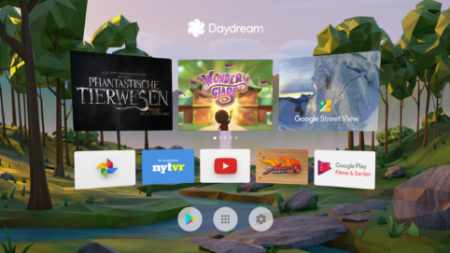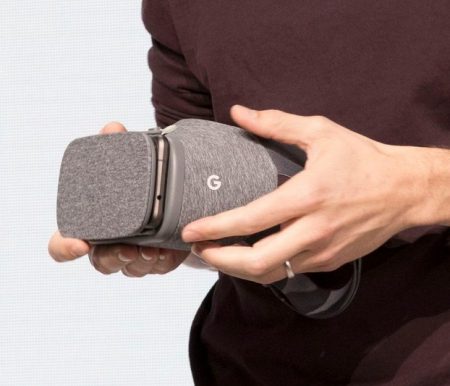October 4, 2016 – Today Google revealed its latest foray into virtual reality, a successor to Cardboard in a headset it calls Daydream View. Priced at $79 U.S., the headset is ergonomically brilliant in its design, a fraction of the weight of its competitors. Open the latch at the front and pop in your smartphone after you download the VR Daydream app and your phone auto aligns and auto connects.
A simple controller enhances the experience. When you finish your virtual reality experience, pop the controller into the slotted space inside the front cover for storage.
Daydream View is covered in fabric that comes in the following colours: slate grey, snow and crimson. It is 30% lighter than other commercial VR headsets and fits over eyeglasses. The controller has a packet of built-in sensors including gyroscope. It is so position sensitive you can use it to draw, swipe, slice, throw, swing and do countless other physical motions.
Apps include a virtual reality version of the Star Chart I currently use on my smartphone, a number of games, educational materials, and streamed movies in VR format. Daydream View lets you use other apps such as Google Play Movies, Google Photos, Street View, Maps, YouTube VR, Netflix, Hulu, and HBO.
The Daydream View headset connects to an inserted smartphone using near-field communication (NFC) protocol which establishes a link when compatible devices are within 4 centimeters (approximately 2 inches) of each other. Even if the phone is not fully inserted in its slot, Daydream View automatically adjusts and orients the image seen by the wearer.
The Daydream View interface appears in the image below.

The $79 price point and the weight of Daydream View are probably its two most disruptive parts of the Google announcement. Daydream View is lightweight making it comfortable to wear. And its price makes name brand models like the Samsung Gear from $108 to $370, LG 360, $300, Zeiss VR One, $180, Occulus Rift, from $599, and HTC Vive, $799, seem awfully pricey.












